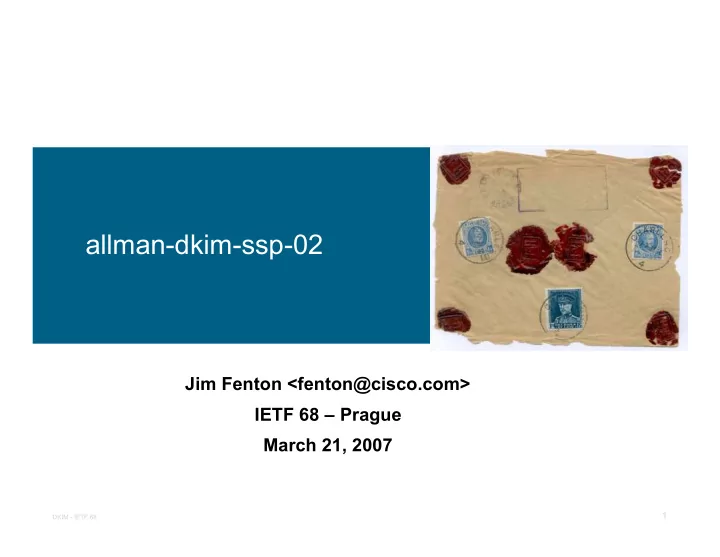

allman-dkim-ssp-02 Jim Fenton <fenton@cisco.com> IETF 68 – Prague March 21, 2007 1 DKIM - IETF 68
SSP recent changes Removal of “user” policy Change in tag names to promote extensibility p -> dkim t -> dkimflag Changes in SSP algorithm to fix problem described at last IETF Current draft is expired, but new one coming soon! 2 DKIM - IETF 68
SSP Open Issues New “DKIMP” resource record vs TXT record “Strict” policy Policies placing limitations on selectors Policies on multiple signatures to aid algorithm transitions Use of PTR/XPTR to locate record Resolution of open issues on SSP requirements 3 DKIM - IETF 68
New SSP Algorithm (1 of 2) 1. If a valid Originator Signature exists, the message is non-Suspicious, and the algorithm terminates. 2. Query DNS for a DKIMP record corresponding to the domain part of the Originator Address. If the result of this query is a NODATA response, proceed to step 6. If the result of this query is a NXDOMAIN response, the message is Suspicious and the algorithm terminates. Otherwise, proceed to the following steps using the record retrieved by the query. 3. If the SSP "dkimflag" tag exists and any of the flags is "t" (indicating testing), the message is non-Suspicious and the algorithm terminates. 4. If the value of the SSP "dkim" tag is "unknown", the message is non-Suspicious and the algorithm terminates. 5. If the value of the SSP "dkim" tag is "all", and one or more Valid Signatures are present on the message, the message is non-Suspicious and the algorithm terminates. Otherwise, the message is Suspicious and the algorithm terminates. 4 DKIM - IETF 68
New SSP Algorithm (2 of 2) 6. (check for parent domain policy) If the parent domain of the previous query is a top-level domain (e.g., a country code) or is on a list of invalid signing entries maintained by the verifier (see dkim-base section 6.1.1), then an SSP record was not found and the message is non-Suspicious and the algorithm terminates. 7. Query DNS for a DKIMP record corresponding to the immediate parent of the previous query. If the result of this query is a NODATA response, then proceed to stop 7. 8. If the SSP "dkimflag" tag exists and any of the flags is "t" (indicating testing) or "s" (indicating that the record should not be used apply to a subdomain), the message is non-Suspicious and the algorithm terminates. Otherwise proceed to step 4. 5 DKIM - IETF 68
New SSP algorithm - comments We’re back to an upward search, but only when a wildcard is present Wildcards seem to be relatively rare Alternative would be to publish wildcard SSP Would also need to publish a “shadow” SSP record for every defined name in the zone Puts more burden on the publisher 6 DKIM - IETF 68
Algorithm with TXT records TXT records would use a prefix, e.g., _policy NXDOMAIN on a query only means there’s no policy Separate query needed to see whether the domain exists Could be overlapped with policy query Tradeoff of lookups vs. ease of deployment of TXT records 7 DKIM - IETF 68
Recommend
More recommend